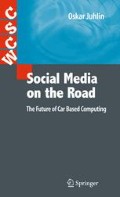Abstract
This chapter addresses mobile phone handling in conjunction with driving to further influence the design of mobile services for car use. Based on an ethnographic field study of naturally occurring phone use while driving, we describe the previously unrecognised interactional adaptation by which the driver fits the engagement with the phone in relation to driving, and vice versa. Drivers adjust their phone handling to collaboration in traffic, and likewise adjust the conversation to the traffic situation by giving non-present conversationalists awareness of problematic traffic situations. Based on these findings we suggest two possible ways to design technologies to improve safety for mobile phone use in cars i.e. either by providing awareness of the traffic to the remote conversational partner, or by increasing the awareness of phone handling to surrounding drivers. Acknowledging these activities make the need to restrict mobile phone use in cars seem less urgent.
This chapter has previously been published as Esbjörnsson et al. (2007). Reprinted from the publication with permission from Taylor and Francis.
Access this chapter
Tax calculation will be finalised at checkout
Purchases are for personal use only
Notes
- 1.
This chapter has previously been published as Esbjörnsson et al. (2007). Reprinted from the publication with permission from Taylor and Francis.
References
Alm H, Nilsson L (1994) Changes in driver behaviour as a function of handsfree mobile phones—a simulator study. Accid Anal Prev 264:441–451
Alm H, Nilsson L (1995) The effects of a mobile telephone task on driver behaviour in a car following situation. Accid Anal Prev 27:707–715
Atkinson JM, Heritage J (1985) Structures of social action: studies in conversation analysis. Cambridge University Press, Cambridge
Brookhuis KA, de Vries G, de Waard D (1991) The effects of mobile telephoning on driving performance. Accid Anal Prev 23(4):309–316
Dannefer D (1977) Driving and symbolic interaction. Sociol Inq 47(1):33–38
Esbjörnsson M, Juhlin O, Weilenmann A (2007) Drivers using mobile phones in traffic: an ethnographic study of interactional adaptation. Int J Hum Comput Interact 22(1):39–60
Fairclough SH, Ashby MC, Ross T et al (1991) Effects of handsfree telephone use on driving behaviour. In: Proceedings of the 24th ISATA international symposium on automotive technology and automation
Glassbrenner D (2005) Driver cell phone use in 2004—overall results. Traffic safety facts—research note, February, DOT HS 809 847
Goodman MJ, Tijerina L, Bents, FD et al (1999) Using cellular telephones in vehicles: safe or unsafe? Transp Hum Factors, 11:3–42
Hammersley M (1992) What’s wrong with ethnography? Routledge, London
Johal S, Napier F, Britt-Compton J et al (2005) Mobile phones and driving. J Public Health 271:112–113
Katz J (1999) How emotions work. University of Chicago Press, Chicago
Kircher A, Törnros J, Vogel K et al (2003) Mobile telephone simulator study. Vetenskaplig rapportsamling—Vägverkets utredning om användning av mobiltelefoner och andra IT-system under körning. Publ: 92, Swedish National Road Administration, Borlänge
Laurier E (2002) Notes on dividing the attention of a car driver. Team Ethno Online, No. 1
Laurier E, Philo C (1998) Meet you at junction 17: a socio-technical and spatial study of the mobile office, Glasgow. Dept. of Geography, University of Glasgow and ESRC, Swindong. http://web2.ges.gla.ac.uk/˜elaurier/texts/proposal.htm. Accessed 17 January 2010
Manalavan P, Samar A, Schneider M et al (2002) In-car cell phone use: mitigating risk by signaling remote callers. In: Proceedings of CHI—extended abstracts on human factors in computing systems. ACM Press, New York, pp 790–791
McCartt AT, Geary LL (2004) Longer term effects of New York State’s law on drivers’ handheld cell phone use. Br Med J 10:11–15
McD Taylor D, Bennet DM, Carter M et al (2003) Mobile telephone use among Melbourne drivers: a preventable exposure to injury risk. Med JAust 179(3):140–142
McEvoy SP, Stevenson MR, McCartt AT et al (2005) Role of mobile phones in motor vehicle crashes resulting in hospital attendance: a case-crossover study. Br Med J. doi:10.1136/bmj.38537.397512.55
McKnight AJ, McKnight AS (1993) The effect of cellular phone use upon driver attention. AccidAnal Prev 25(3):259–265
National Highway Traffic Safety Administration (NTHSA) (1997) An investigation of the safety implications of wireless communications in vehicles. Department of Transportation. http://www.nhtsa.dot.gov/people/injury/research/wireless. Accessed 17 January 2010
Reed PM, Green PA (1999) Comparison of driving performance on-road and in a low-cost simulator using a concurrent telephone dialing task. Ergonomics 428:1015–1037
Redelmeier D, Tibshirani RJ (1997) Association between cellular telephone calls and motor vehicle collisions. New Engl J Med 336(7):453–458
Schegloff E (2002) Beginnings in the telephone. In: Katz J, Aakhus M (eds) Perpetual contact: mobile communication, private talk, public performance. Cambridge University Press, Cambridge
Serafin C, Wen C, Paelke G et al (1993) Car phone usability: a human factors laboratory test. In: Proceedings of the human factors and ergonomics society 37th annual meeting
Silverman D (1998) Harvey sacks—social science & conversation analysis. Oxford University Press, New York
SOU (2003) Trängselavgifter. Statens Offentliga Utredningar. 2003:61. http://www.regeringen.se/sb/d/263/a/1912. Accessed 17 January 2010
Svenson O, Patten C (2003) Information technology in the car: mobile phones and traffic safety—a review of contemporary research. In Vetenskaplig rapportsamling—Vägverkets utredning om användning av mobiltelefoner och andra IT-system under körning. Publ 2003:92, Swedish National Road Administration, Borlänge
Author information
Authors and Affiliations
Corresponding author
Rights and permissions
Copyright information
© 2010 Springer-Verlag London Limited
About this chapter
Cite this chapter
Juhlin, O. (2010). Interactional Adaptation for Achieving Safe Mobile Phone Handling in Traffic. In: Social Media on the Road. Computer Supported Cooperative Work, vol 50. Springer, London. https://doi.org/10.1007/978-1-84996-332-9_5
Download citation
DOI: https://doi.org/10.1007/978-1-84996-332-9_5
Published:
Publisher Name: Springer, London
Print ISBN: 978-1-84996-331-2
Online ISBN: 978-1-84996-332-9
eBook Packages: Computer ScienceComputer Science (R0)

